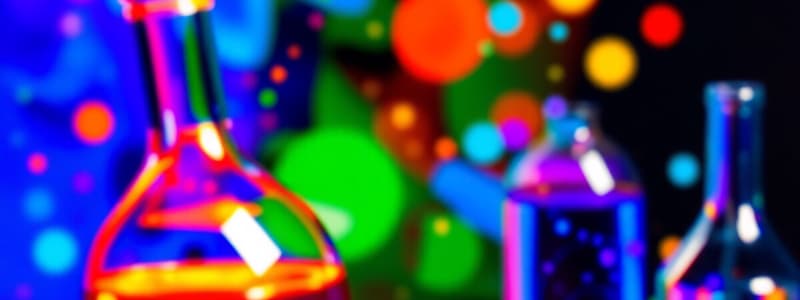Podcast
Questions and Answers
What is one of the primary pharmaceutical applications of Infrared Spectroscopy?
What is one of the primary pharmaceutical applications of Infrared Spectroscopy?
- Quantitative measurement of drug concentrations
- Qualitative fingerprint check for identity of raw materials (correct)
- Assessment of drug stability over time
- Kinetic study of drug interactions
Which types of transitions do molecules undergo during Infrared Spectroscopy?
Which types of transitions do molecules undergo during Infrared Spectroscopy?
- Chemical and physical transitions
- Thermal and structural transitions
- Vibrational and rotational transitions (correct)
- Electronic and magnetic transitions
How is the IR spectrum typically plotted?
How is the IR spectrum typically plotted?
- As a percentage of absorption versus wavelength
- As a graph of intensity versus frequency
- As energy versus time
- As wavenumber (cm-1) versus intensity (correct)
What underlies the origin of the IR spectrum at the molecular level?
What underlies the origin of the IR spectrum at the molecular level?
What is a useful method of sample preparation for analyzing solid samples with IR Spectroscopy?
What is a useful method of sample preparation for analyzing solid samples with IR Spectroscopy?
Infrared Spectroscopy is primarily used for identifying which type of molecular characteristics?
Infrared Spectroscopy is primarily used for identifying which type of molecular characteristics?
Which statement best describes vibrational energy levels in a molecule?
Which statement best describes vibrational energy levels in a molecule?
In which scenario would Infrared Spectroscopy not be effectively used?
In which scenario would Infrared Spectroscopy not be effectively used?
Which type of molecular vibrations specifically absorb IR radiation?
Which type of molecular vibrations specifically absorb IR radiation?
What condition must be met for a molecule to absorb IR radiation?
What condition must be met for a molecule to absorb IR radiation?
Which of the following statements is true regarding symmetrical molecules and IR absorption?
Which of the following statements is true regarding symmetrical molecules and IR absorption?
What is the primary reason complicated compounds produce many bands in an IR spectrum?
What is the primary reason complicated compounds produce many bands in an IR spectrum?
Which of the following vibration modes contributes a peak close to 3756 cm-1 in an IR spectrum?
Which of the following vibration modes contributes a peak close to 3756 cm-1 in an IR spectrum?
For which purpose is the IR spectrum commonly utilized in pharmaceutical applications?
For which purpose is the IR spectrum commonly utilized in pharmaceutical applications?
What is typically involved in sample preparation for IR spectroscopy?
What is typically involved in sample preparation for IR spectroscopy?
Which characteristic distinguishes between anti-symmetric and symmetric stretching modes?
Which characteristic distinguishes between anti-symmetric and symmetric stretching modes?
What is the main purpose of using IR spectroscopy in pharmaceuticals?
What is the main purpose of using IR spectroscopy in pharmaceuticals?
What characteristic of the fingerprint region makes it difficult to assign all absorption bands?
What characteristic of the fingerprint region makes it difficult to assign all absorption bands?
Which bond requires the most energy to stretch according to the provided data?
Which bond requires the most energy to stretch according to the provided data?
How can solvent residues affect the purity determination of compounds using IR spectroscopy?
How can solvent residues affect the purity determination of compounds using IR spectroscopy?
Which technique is used to prepare solid samples for IR spectroscopy?
Which technique is used to prepare solid samples for IR spectroscopy?
What information can be obtained from the peak intensities in an IR spectrum?
What information can be obtained from the peak intensities in an IR spectrum?
Which statement accurately describes the bond strength of C-H compared to N-H and O-H?
Which statement accurately describes the bond strength of C-H compared to N-H and O-H?
What kind of molecular transition is primarily analyzed in IR spectroscopy?
What kind of molecular transition is primarily analyzed in IR spectroscopy?
What is the significance of using the British Pharmocopoeia (BP) in pharmaceutical IR spectroscopy?
What is the significance of using the British Pharmocopoeia (BP) in pharmaceutical IR spectroscopy?
What is the primary reason for needing longer path lengths when analyzing gases with IR spectroscopy?
What is the primary reason for needing longer path lengths when analyzing gases with IR spectroscopy?
How does the mass of an atom influence its absorption frequency in infrared spectroscopy?
How does the mass of an atom influence its absorption frequency in infrared spectroscopy?
What effect does bond strength have on the absorption frequency of a molecule?
What effect does bond strength have on the absorption frequency of a molecule?
In the context of group frequencies, why is it important to use correlation charts for interpreting IR spectra?
In the context of group frequencies, why is it important to use correlation charts for interpreting IR spectra?
What is the importance of absorption bands appearing at the same frequency for multiple molecules?
What is the importance of absorption bands appearing at the same frequency for multiple molecules?
How does the understanding of normal modes of vibration assist in analyzing compounds like water and carbon dioxide?
How does the understanding of normal modes of vibration assist in analyzing compounds like water and carbon dioxide?
What type of molecular vibrations can absorb infrared radiation?
What type of molecular vibrations can absorb infrared radiation?
Why do complicated compounds produce multiple bands in an IR spectrum?
Why do complicated compounds produce multiple bands in an IR spectrum?
What is required for a molecule to exhibit absorbance in the IR region?
What is required for a molecule to exhibit absorbance in the IR region?
What is the main difference between symmetrical and anti-symmetric stretching?
What is the main difference between symmetrical and anti-symmetric stretching?
What role does frequency play in molecular vibrations for IR spectra?
What role does frequency play in molecular vibrations for IR spectra?
Which molecular configurations exhibit IR absorptions under normal circumstances?
Which molecular configurations exhibit IR absorptions under normal circumstances?
What is the significance of bending vibrations in relation to IR absorption?
What is the significance of bending vibrations in relation to IR absorption?
At what wavenumbers do some common molecular vibrations occur according to the provided data?
At what wavenumbers do some common molecular vibrations occur according to the provided data?
What are the two additional types of radiation-induced transitions observed in molecules during Infrared Spectroscopy?
What are the two additional types of radiation-induced transitions observed in molecules during Infrared Spectroscopy?
Explain how the energy required for vibrational transitions compares to that needed for electronic transitions.
Explain how the energy required for vibrational transitions compares to that needed for electronic transitions.
What type of spectrum is produced by Infrared Spectroscopy, and what is it plotted as?
What type of spectrum is produced by Infrared Spectroscopy, and what is it plotted as?
How does the infrared spectrum assist in the identification of functional groups within a molecule?
How does the infrared spectrum assist in the identification of functional groups within a molecule?
What molecular concepts underlie the appearance of an IR spectrum?
What molecular concepts underlie the appearance of an IR spectrum?
Describe the nature of vibrational energy levels in molecules.
Describe the nature of vibrational energy levels in molecules.
What is one of the primary roles of Infrared Spectroscopy in the pharmaceutical industry?
What is one of the primary roles of Infrared Spectroscopy in the pharmaceutical industry?
In terms of sample states, what types of samples can Infrared Spectroscopy analyze?
In terms of sample states, what types of samples can Infrared Spectroscopy analyze?
What is the frequency range associated with the fingerprint region in an IR spectrum?
What is the frequency range associated with the fingerprint region in an IR spectrum?
Which bond requires the least amount of energy to stretch, as indicated by the provided bond strength data?
Which bond requires the least amount of energy to stretch, as indicated by the provided bond strength data?
In IR spectroscopy, what happens when a molecule has a symmetrical structure?
In IR spectroscopy, what happens when a molecule has a symmetrical structure?
What is the significance of the British Pharmocopoeia (BP) in IR spectroscopy for pharmaceuticals?
What is the significance of the British Pharmocopoeia (BP) in IR spectroscopy for pharmaceuticals?
How do solvent residues affect the interpretation of an IR spectrum concerning purity?
How do solvent residues affect the interpretation of an IR spectrum concerning purity?
What role does the group frequency region (4000 – 1500 cm-1) play in IR spectroscopy?
What role does the group frequency region (4000 – 1500 cm-1) play in IR spectroscopy?
Why is it challenging to assign all absorption bands in the fingerprint region?
Why is it challenging to assign all absorption bands in the fingerprint region?
What method is typically used to prepare solid samples for IR spectroscopy?
What method is typically used to prepare solid samples for IR spectroscopy?
What can be inferred about the strength of an O-H bond based on its bond energy compared to C-H and N-H?
What can be inferred about the strength of an O-H bond based on its bond energy compared to C-H and N-H?
What is required for a molecule to exhibit IR absorption?
What is required for a molecule to exhibit IR absorption?
Flashcards
IR spectroscopy
IR spectroscopy
A technique that analyzes the vibrational energy of bonds in molecules using infrared light.
Group frequency region
Group frequency region
The region in an IR spectrum (4000-1500 cm⁻¹) where stretching vibrations of diatomic units are usually found.
Fingerprint region
Fingerprint region
The region in an IR spectrum (1500-400 cm⁻¹) characterized by complex patterns of absorption bands, used for confirming structures.
Bond stretching
Bond stretching
Signup and view all the flashcards
Bond strength (kJ/mol)
Bond strength (kJ/mol)
Signup and view all the flashcards
IR frequency
IR frequency
Signup and view all the flashcards
Sample preparation (liquids)
Sample preparation (liquids)
Signup and view all the flashcards
Sample preparation (solids)
Sample preparation (solids)
Signup and view all the flashcards
British Pharmacopoeia (BP)
British Pharmacopoeia (BP)
Signup and view all the flashcards
IR Analysis (impurities)
IR Analysis (impurities)
Signup and view all the flashcards
Infrared Spectroscopy
Infrared Spectroscopy
Signup and view all the flashcards
Vibrational Transitions
Vibrational Transitions
Signup and view all the flashcards
IR Spectrum
IR Spectrum
Signup and view all the flashcards
Wavenumber (cm-1)
Wavenumber (cm-1)
Signup and view all the flashcards
Functional Groups
Functional Groups
Signup and view all the flashcards
Electronic Transition
Electronic Transition
Signup and view all the flashcards
UV-Visible Spectroscopy
UV-Visible Spectroscopy
Signup and view all the flashcards
Sample Preparation
Sample Preparation
Signup and view all the flashcards
IR radiation vs. UV
IR radiation vs. UV
Signup and view all the flashcards
Vibrational Modes
Vibrational Modes
Signup and view all the flashcards
Symmetrical vs. Asymmetrical Stretching
Symmetrical vs. Asymmetrical Stretching
Signup and view all the flashcards
Polarisability and IR Absorption
Polarisability and IR Absorption
Signup and view all the flashcards
Infrared Spectrum
Infrared Spectrum
Signup and view all the flashcards
Complicated Compounds and IR
Complicated Compounds and IR
Signup and view all the flashcards
Anti-symmetric Stretching and IR Absorption
Anti-symmetric Stretching and IR Absorption
Signup and view all the flashcards
Identifying Molecules with IR Spectroscopy
Identifying Molecules with IR Spectroscopy
Signup and view all the flashcards
What's UV-Vis spectroscopy used for?
What's UV-Vis spectroscopy used for?
Signup and view all the flashcards
IR spectroscopy: where does the energy go?
IR spectroscopy: where does the energy go?
Signup and view all the flashcards
What makes a molecule IR active?
What makes a molecule IR active?
Signup and view all the flashcards
Two types of IR vibrations
Two types of IR vibrations
Signup and view all the flashcards
What's the fingerprint region in IR spectroscopy?
What's the fingerprint region in IR spectroscopy?
Signup and view all the flashcards
Why is IR spectroscopy important in pharmaceuticals?
Why is IR spectroscopy important in pharmaceuticals?
Signup and view all the flashcards
What are some ways to prepare samples for IR analysis?
What are some ways to prepare samples for IR analysis?
Signup and view all the flashcards
How does IR spectroscopy reveal structure?
How does IR spectroscopy reveal structure?
Signup and view all the flashcards
IR radiation energy
IR radiation energy
Signup and view all the flashcards
Stretching Vibrations
Stretching Vibrations
Signup and view all the flashcards
Bending Vibrations
Bending Vibrations
Signup and view all the flashcards
Polarisability
Polarisability
Signup and view all the flashcards
IR Absorption
IR Absorption
Signup and view all the flashcards
Complex Molecules and IR
Complex Molecules and IR
Signup and view all the flashcards
What affects IR absorption frequency?
What affects IR absorption frequency?
Signup and view all the flashcards
How does mass affect IR frequency?
How does mass affect IR frequency?
Signup and view all the flashcards
How does bond strength affect IR frequency?
How does bond strength affect IR frequency?
Signup and view all the flashcards
What are group frequencies?
What are group frequencies?
Signup and view all the flashcards
What are correlation charts?
What are correlation charts?
Signup and view all the flashcards
Stronger Bond, Higher Frequency
Stronger Bond, Higher Frequency
Signup and view all the flashcards
IR Spectra for Purity
IR Spectra for Purity
Signup and view all the flashcards
IR Spectroscopy: Different Samples
IR Spectroscopy: Different Samples
Signup and view all the flashcards
UV and IR Energy Differences
UV and IR Energy Differences
Signup and view all the flashcards
Study Notes
Introduction to Organic Spectroscopy
- Organic spectroscopy is an introduction to pharmaceutical chemistry
- The lecture discusses UV-VIS and Infrared (IR) Spectroscopy.
- UV-VIS spectroscopy involves electromagnetic radiation between 180-780 nm interacting with molecules.
- Absorption of energy causes excitation of an electron to a higher energy level.
- IR spectroscopy uses lower energy electromagnetic radiation for vibrational and rotational transitions within molecules.
- IR radiation involves stretching and bending of bonds in the molecule.
Infrared Spectroscopy
- IR spectra are absorption spectra
- IR radiation has enough energy to stretch or bend bonds in molecules.
- The spectrum is plotted as wavenumber (cm⁻¹).
- IR radiation is lower energy than UV radiation.
- For a bond to absorb IR radiation, the bond must be polarizable.
- Asymmetrical vibrations are the ones that absorb IR.
- Symmetrical molecules don't absorb IR unless asymmetric stretching/bending is possible
Vibrational Modes
- Symmetrical stretch
- Asymmetrical stretch
- Bend
- These modes create different frequencies of radiation absorption in the IR spectrum.
- Complicated compounds have more than one way to vibrate, resulting in multiple absorption bands.
Regions of the IR Spectrum
- The intensity of light absorption changes in different parts of the region
- Higher frequency regions for a shorter wavelength are associated with bonds to hydrogen atoms.
- Lower frequency regions for a longer wavelength are associated with heavier atoms/bonds
Group Frequencies
- Absorption frequency depends on the mass (heavy or light atoms) and bond strength of bonded atoms in the regions.
- Tables or databases of group frequencies can aid in determining functional groups within molecules.
- One absorption band can appear at the same frequency for many different molecules.
Applications of Infrared Spectroscopy in Pharmaceuticals
- Qualitative tests for drugs and materials used in drug manufacturing.
- Identification of functional groups in molecules.
- Analysis of solid and semi-solid pharmaceutical forms, e.g., creams and tablets.
Sample Preparation Methods for IR Spectroscopy
- Liquid films: spreading a drop of liquid between IR plates
- Solutions: using suitable solvents and background correction with a blank solvent
- Solids: ground solids to a paste with a mulling agent (e.g., mineral oil) or with KBr in a mortar
British Pharmacopoeia (BP) Standards for IR Spectroscopy
- BP uses IR spectra of standard compounds to verify the identity of the drug.
- The IR spectrum of an unknown drug must exactly match the spectrum of a standard compound
- All peaks and intensities in the spectra should match exactly.
- Functional groups at specific frequencies can aid in determining purity.
Studying That Suits You
Use AI to generate personalized quizzes and flashcards to suit your learning preferences.



